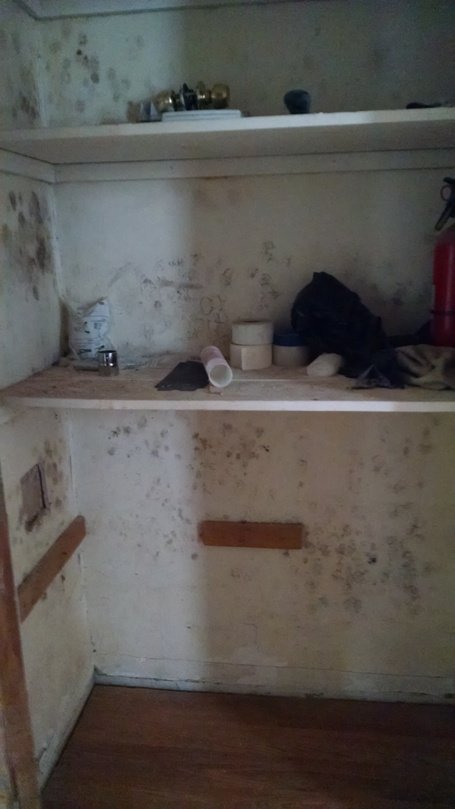Find a Mold Specialist Now
Click or Call, Toll-Free 24/7
Cladosporium Mold In The Home
Cladosporium is a common type of mold often found both outdoors and indoors. Outdoors, it is often found on plants. Outdoor mold may trigger allergic reactions in some people but rarely causes serious problems. Indoors, on the other hand, mold can damage your home and cause numerous health problems. That’s because the concentration of mold indoors is much greater than outdoors, so your exposure is much greater. Also, most people spend more time in their homes than outdoors.
 Closet With Mold
Closet With MoldCladosporium in the Home
In the home, this type of mold is often found on wallpaper and on carpet where there is, or has recently been, excessive moisture. It may also be found around windows where there is moisture due to condensation and on damp shower walls. While it’s often found in bathrooms, it can be found in other rooms, too.
This type of mold may appear black, brown or green in color. You may just see small dots of it rather than large areas, although if it doesn’t get cleaned up, the dots may merge into one large patch of mold.
Keep in mind the fact that there are other strains of mold that are similar in color and you can’t accurately identify the type of mold by looking at it. If you need to know what type of mold is growing in your home, you can have a certified mold tester come in and test it. The Centers for Disease Control and Prevention says that most of the time, it doesn’t really matter what specific strains of mold are growing in your home because all of them can be harmful. If you decide you do want to find out what kind of mold you have in your home, though, follow this link to find certified mold testers in your area.
Health Problems Associated with Cladosporium
While it is possible to be allergic to any type of mold, many people are allergic to this one. Symptoms of allergic reactions may include coughing, sneezing, wheezing, difficulty breathing, sore throat, headache, runny nose, sinus congestion, and itchy, watery eyes. A skin rash or hives may also result.
According to the Centers for Disease Control and Prevention (CDC) this strain of mold can also cause infections, including sinus infections, ear infections, eye infections and even infections of the brain. Small children, elderly people, and those with weakened immune systems are most susceptible to infections caused by mold, although even healthy adults can sometimes fall victim to them.
This type of mold is also associated with asthma attacks and asthma-like symptoms. Of course, those with asthma or other respiratory disorders are at greater risk, but those without a previous history of asthma can develop asthma-like symptoms.
Let your health care provider know if you’ve been exposed to mold in the home or if you think exposure to mold might be causing your symptoms. If your health care provider feels it is necessary to know what kind of mold is making you ill, he or she can order blood tests to check for antibodies to specific strains of mold or you can have the mold in your home tested.
In order to prevent mold-related health problems, it is recommended that people with mold allergies, asthma or other respiratory disorders take steps to prevent the development of mold in their homes. Follow this link to learn about how to prevent mold in your house.
Removing Cladosporium from Your Home
Whether it’s this type of mold or another type, you need to have the mold removed in order to protect your home from damage and to protect your health and the health of your family.
If you’re dealing with only a small amount of mold and you’re not experiencing any mold-related health problems, you may be able to remove the mold yourself. If you have large amounts of mold in the home, or if you are experiencing mold-related health problems, the Environmental Protection Agency recommends calling in a professional. Whether you plan to handle the job yourself or want to hire someone, we recommending scheduling a free in-home consultation with a mold removal professional. A professional will visit your home, inspect for mold, advise you about the cleanup process and answer any questions you may have. Be sure to ask about safety precautions you should take if you opt to tackle the cleanup on your own, so that you don’t inadvertently make yourself ill during the process. To find qualified mold removal professionals offering free in-home consultations in your area, just follow the link.
Return From Cladosporium Mold To Our Main Mold Types Page
Ref:
CDC: Cladosporium




